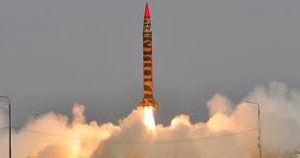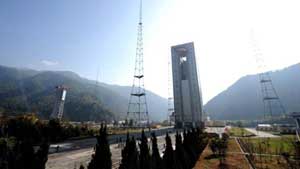November 2019 Science and Technology
Sakshi Education

- India successfully test fired Prithvi 2
India successfully test fired its indigenously developed nuclear capable surface-to-surface Prithvi-2 missile from a test range off Odisha coast.
Two Prithvi-2 missiles were test fired consecutively and both tests met all parameters.
Prithvi-2 is capable of carrying 500-1,000 kg of warheads and is powered by liquid propulsion twin engines.
- India’s earth observation satellite Cartosat-3 to be launched tomorrow (27th Nov)
India’s latest earth observation satellite Cartosat-3 will be launched tomorrow (27 November, 2019) morning. The national space agency ISRO says, the satellite will be launched along with 13 customer payloads from the US from the Satish Dhawan Space Center at Sriharikota at 09:28 hours on 27 November, 2019, using the workhorse rocket PSLV-C47.
The 26-hour countdown for the launch mission began this morning at 07:28 hours. The rocket will Cartosat-3 at a height of 509 kilometers and will be stabilized in a polar Sun-synchronous orbit. Its operational life would be five years. This is the first mission by the ISRO after the Chandrayaan-2 mission. It has a very high-resolution camera that will be helpful in meeting the increased user demands for urban planning, infrastructure development, coastal land use and land cover.
- ISRO launches India’s latest earth observation satellite Cartosat-3 successfully
The national space agency ISRO launched the latest Earth observation satellite, Cartosat-3 successfully on 27 November, 2019. The workhorse rocket PSLV in its C-47 version carried it along with 13 other customer payloads into the intended polar sun-synchronous orbit.
The launch vehicle was ignited at 09.28 AM from the second launch pad of the Satish Dhawan Space Centre at Sriharikota in Andhra Pradesh, some 90 kilometres off Chennai. In just under 18 minutes, the third generation, agile, advanced satellite Cartosat-3 was injected at a height of 509 kilometres from the surface of the earth.
The separation of the customer payloads belonging to a US space technology firm followed the Cartosat-3 to get separated from the launch vehicle one after the other. The whole launch mission got over in just under 27 minutes.
He also said thirteen more missions will be carried out by March 2020, including six vehicle missions and seven satellite missions.
For the PSLV, this is the 49th flight overall. In total, this is the fifth flight for the national space agency this year. As the total weight of all the satellites put together is a bit heavy, six solid strap-on boosters are incorporated in the rocket to give the needed extra thrust, which is known as the XL-configuration.
In total, Cartosat-3 is the ninth satellite of its class and is the first in the series of the third generation payloads. Cartosat-3 weighs a little over 1.6 ton and has the capacity to generate 2000 MW power, using its solar panels. Its operational life is five years.
- Astronomers Have Detected Record-Breaking Light Emissions from Gamma-Ray Bursts
Scientists have managed to see two violent explosions in galaxies that are billions of light-years away. The results from the study published in the journal Nature.
The explosions were gamma-rays bursts or short eruptions of the most energetic form of light.
The second captured in January, produced light that contained 100 billion times as much energy as the light visible to human eyes.
The telescopes (Hubble Space Telescope) on Earth had to catch the light barely 50 seconds after the Gamma-ray bursts appeared since they last for only a few seconds. The Major Atmospheric Gamma Imaging Cherenkov (MAGIC) telescopes in the Canary Islands were the first to see the bursts.
- Intel Partners With MediaTek to Bring 5G Support to Laptops
MediaTek planned to partner with Intel, the Taiwanese chipmaker, to be the first original equipment manufacturers (OEMs) to deliver laptops powered by Intel and MediaTek's 5G solution.
Through this partnership, Intel working with MediaTek on the 5G solution for deployment in key consumer and commercial laptop segments. MediaTek is developing the 5G modem and working with partners to manufacture the solution.
The consumers will be able to browse, stream, and game faster on their PCs, but we also expect them to innovate with 5G.MediaTek's new 5G modem for PCs is based in part on its Helio M70 5G modem it introduced earlier this year as part of its integrated 5G system-on-chip for the first wave of 5G flagship smartphones.
Intel's partnership with MediaTek brings together industry leaders with in-depth engineering, system integration, and connectivity expertise to deliver 5G experiences on the next generation of the world's best PCs.
- UIDAI launched the new version of mAadhaar application
The Unique Identification Authority of India (UIDAI) has launched the new version of the mAadhaar application, both for Android and iOS devices. The application aims to make the mAadhaar application more secure.
mAadhaar application:
To avail the new version, the users should delete the previous version and install the new version immediately
Third-party applications are not supported by the UIDAI
Users can download Aadhaar card, offline eKYC, show or scan QR code, order a reprint, update address, verify Aadhaar, verify mail/email, retrieve Unique Identification Number (UID) or Enrolment Number (EID), request for Address Validation Letter
They can also check the status of various online requests using the new version of the app.
- Indian Army inducted ATGMS Spike along LoC in Jammu and Kashmir
The Indian Army has inducted anti-tank guided missiles (ATGMs) Spike along the Line of Control (LoC) in northern command theatre in Jammu and Kashmir.
The induction aims to strengthen the defence along the country's border with Pakistan.
India-Israel deal:
Israel delivered a total of 210 missiles along with 12 launchers to India under an Rs.280 crore deal.
The delivery is a part of Israel's emergency purchase mechanism. The deal was made between India and Israel, after the Pakistani army moved some of its troops to the border following the Indian Air Force's strike on terror camps in Balakot, deep inside Pakistan.
Spike ATGM:
Spike missiles are developed and manufactured in Israel. The anti-tank guided missile and anti-personnel missile with a tandem-charge HEAT warhead.
Currently, the fourth-generation of the missiles are in use. It is known as the fire and forget missiles.
The Spike ATGMs are portable by men.
The missiles can destroy tanks and bust bunkers within four kilometers.
In October 2019, these anti-tank guided missiles and its launchers were inducted along the LoC in the northern theatre.
- NuGen Mobility Summit 2019 is being held at ICAT, Gurugram
The NuGen Mobility Summit 2019 was held at the International Centre for Automotive Technology Centre, ICAT in Gurugram, Haryana.
The summit was addressed by the Minister of Road Transport and Highways Nitin Gadkari. The summit will be held from 27-29 November 2019.
NuGen Mobility Summit 2019:
The 2019 NuGen Mobility Summit discussed the auto industry to think about future technologies as skilled man-power, cheap labour, and technology that are available in the auto sector.
Discussion about the Ethanol, Methanol, Bio-diesel, and Bio-CNG will support future technology to be utilized in the auto sector was included.
It is expected that the new motor vehicle act will encourage new innovation and research.
The experts share their experiences and learn about trends and innovation in automotive technology.
Participants: Experts from the automotive industry, system and technology companies, experts in technology domains, researchers, policymakers, test houses and agencies, associations and academia from all around the world are participating in the summit.
- Researchers discovered a massive black hole in the Milky Way
Researchers from the National Astronomical Observatory of China have discovered a black hole in the Milky Way.
The black hole is so huge that it challenged the existing models of the evolution of stars. The black hole was discovered by an international team of scientists using China's sophisticated Large Sky Area Multi Object Fibre Spectroscopic Telescope (LAMOST) telescope.
LB-1:
The black hole, LB-1, is located 15,000 light-years away from Earth
LB-1 has a mass 70 times greater than the Sun
The large mass of LB-1 falls into a range known as the pair-instability gap
The size of LB-1 was confirmed by two other world's largest optical telescopes namely Spain's Gran Telescopio Canarias and the Keck I telescope in the United States.
- Centre to set up a new rocket launch pad at Kulasekarapattinam
The government of India is to set up a new rocket launch pad near Kulasekarapattinam in the State of Tamil Nadu.
It was announced by the Union Minister of Atomic Energy and Space, Dr. Jitendra Singh. The move is because of the increasing launches from India for both domestic and international customers.
Necessity:
Currently, the ISRO has two launch pads at Sriharikota, Andhra Pradesh. The number of satellites launched every year by ISRO has increased over 30. In 2018 alone, ISRO has launched 17 missions. From the year 1994 to 2015, ISRO's PSLV has launched around 84 satellites.
Satish Dhawan Space Centre, SHAR spaceport at Sriharikota, which is responsible for the integration of launchers, houses two operational launch pads.
The new launchpad will be used for future Indian rockets including small satellite launch vehicles, the Unified Modular Launch Vehicle, Geosynchronous Satellite Launch Vehicle Mk III, Avatar Reusable Launch Vehicle (Avatar RLV), Polar Satellite Launch Vehicle (PSLV) and Geosynchronous Satellite Launch Vehicle (GSLV).
- ISRO transferred space grade Li-Ion cell technology to BHEL
Indian Space Research Organization (ISRO) transferred its indigenous technology to produce space-grade lithium-ion cells (Li-ion cells) to Bharat Heavy Electricals Limited (BHEL) as per the TTA signed in March 2018.
BHEL is setting up the Li-Ion production facility near Bangalore in Karnataka. The announcement was given by the Union Minister of Atomic Energy and Space Dr. Jitendra Singh.
BHEL's new facility:
BHEL has procured and commission the various equipments, both indigenous and imported, to establish the facility.
After the agreement, ISRO has provided all technical documentation that will be needed to establish the production plant and hands-on training in various production activities for BHEL staff at ISRO's facilities.
As per the Technology Transfer Agreement, space-grade Li-Ion cells manufactured by BHEL are meant for meeting the national requirements only. However, BHEL can also sell the space-grade Li-Ion cells to parties outside India after obtaining prior written consent from ISRO.
Background:
In March 2018, BHEL signed the Technology Transfer Agreement (TTA) with ISRO to acquire the Li-ion Cell production technology. The TTA was signed at ISRO Headquarters, Bengaluru. The production facility will target to meet the Li-Ion Cell requirements for ISRO and other strategic sectors. With this TTA, BHEL can produce and sell Li-Ion cells to meet the other national and commercial applications by modifying the space-grade cell as per the requirement. It is expected that it can lead to cost reduction.
- DAC approved weapons worth more than Rs.22,800 crore
The Defence Acquisition Council (DAC) chaired by Defence Minister Rajnath Singh approved procurements of anti-submarine P-8I aircraft, airborne warning aircraft, and thermal imaging sights for assault rifles worth more than Rs.22,800 crore on 28 November.
Aim:
The aim of the procurement is to promote defence services. The procurement will strengthen the Navy's capabilities for Anti-Submarine Warfare (ASW), maritime coastal surveillance, and Anti-Surface Vessel (ASV) strike.
Other approvals:
DAC also approved the procurement of long-range Anti-submarine Warfare P-8I aircraft for the Navy.
DAC revalidated the Acceptance of Necessity for the procurement of additional Airborne Warning and Control System (AWACS) aircraft as a follow up to the indigenous Airborne Early Warning and Control (AEW&C) programme.
Implementation:
The mission system and sub-systems for these approved aircraft will be indigenously designed, developed and integrated into the main platform by Defence Research and Development Organization (DRDO).
- Centre to set up Atal Innovation Mission (AIM)
The Government has set up the Atal Innovation Mission (AIM) at NITI Aayog. It encourages the schools to provide exposure to science and technology to students so that they can be acquainted with futuristic technology platforms.
It was announced by the Union Minister for Human Resource Development, Dr. Ramesh Pokhriyal 'Nishank'.
Aim:
The main objective of establishing AIM is to create scientific character and innovative thoughts among the young minds of the country.
AIM-Atal Tinkering Laboratories:
AIM is to establish Atal Tinkering Laboratories (ATL) across the country for students between grade 6th to 12th
The lab will be equipped with the latest emerging technologies such as electronics, Internet of things (IoT), 3D printing, Robotics, etc.
In schools, AIM will facilitate to set up a network of ATL in India.
ATL:
ATL initiative aims to Cultivate 1 Million children in India as Neoteric Innovators. It aims to foster creativity, curiosity, and imagination in young minds and inculcate skills including computational thinking, design mind-set, adaptive learning, rapid calculations, physical computing, measurements, etc.
Implementation:
So far, ATL has selected 8878 schools and 4680 schools have been given the ATL grant in aid for the establishment of ATL.
The government has announced a total of Rs. 1000 crores for AIM up to the financial year 2019-20. There is no direct allocation of funds by AIM at a state and district level. The funds will be directly allocated by AIM to the beneficiaries and administered centrally.
- Pakistan successfully test-fired Shaheen-I missile
 Pakistan successfully test-fired Shaheen-I missile on 18th November 2019. It is a nuclear-capable surface-to-surface ballistic missile. The missile can strike targets up to 650 kilometres. It has the ability to bring a number of Indian cities under its range. The test-firing of the missile comes amidst Indo-Pak tensions over New Delhi revoking Jammu and Kashmir's special status.
Pakistan successfully test-fired Shaheen-I missile on 18th November 2019. It is a nuclear-capable surface-to-surface ballistic missile. The missile can strike targets up to 650 kilometres. It has the ability to bring a number of Indian cities under its range. The test-firing of the missile comes amidst Indo-Pak tensions over New Delhi revoking Jammu and Kashmir's special status.
The launch of Shaheen-I missile was held as part of a training exercise that aimed to test the operational readiness of the Pakistan Army Strategic Forces Command (ASFC). It also ensures Pakistan's credible minimum deterrence.
Shaheen-I:
The Shaheen-I missile is capable of delivering all types of warheads.
It is a land-based supersonic missile.
The surface-to-surface guided ballistic missile ranges up to 650 km.
The missile was designed and developed by the joint venture of the National Defence Complex (NDC) of Pakistan and NESCOM.
- ISRO to launch Cartosat-3, 13 nanosatellites from US
The Indian space agency, Indian Space Research Organisation (ISRO), is to launch its cartography satellite Cartosat-3 and 13 commercial nanosatellites into sun-synchronous orbit on 25 November.
ISRO's rocket Polar Satellite Launch Vehicle-XL variant (PSLV-C47) will put into orbit Cartosat-3 and 13 commercial nanosatellites from the US on 25 November. PSLV-C47 is the 21st flight of PSLV in XL configuration.
The satellite will be placed in an orbit of 509 km at an inclination of 97.5 degrees.
13 nanosatellites:- The 13 nanosatellites from the US is a part of the commercial arrangement with NewSpace India Ltd. NSIL is a new company that was set up recently under the Department of Space.
- Cartosat-3 satellite is a third-generation agile, advanced satellite with high-resolution imaging capability.
- It is an earth observational or remote sensing satellite.
- It can produce images with one of the most high-resolution in the world, and certainly the highest of any satellites under ISRO's umbrella.
- Cartosat-3 has an advanced and better spatial version with a resolution of up to 0.25m (25cm) as compared to the Cartosat-2 series satellites.
- It has been developed so, as it is to produce high-resolution pictures that will be used for strategic applications.
- It is fitted with advanced remote sensing tools that will be helpful with defence. CartoSAT-3 has been designed in a way that it will be one of the most advanced imaging satellites ever built by ISRO.
- In its observation mission, the satellite has powerful capabilities in multiple different spectral characteristics, including:
- panchromatic - captures all visible colors of light
- multispectral - capture light within specific ranges in the electromagnetic spectrum
- hyperspectral - captures light from across the electromagnetic spectrum
- ICGS Amrit Kaur delivered to ICG
Garden Reach Shipbuilders and Engineers (GRSE) delivered its 102nd warship, ICGS Amrit Kaur, to the Indian Coast Guard.
ICGS ‘Amrit Kaur’ is a 50-metre-long and 7.5- metre- wide medium-range surface vessel, with a displacement of around 308 tonnes.
It is capable of performing rescue, patrolling, anti- smuggling and anti-poaching operations in the maritime zones of the country.
- NASA unveiled its first electric airplane
 NASA showcased an early version of its first all- electric experimental aircraft, the X-57 "Maxwell," on 8th Nov 2019.
NASA showcased an early version of its first all- electric experimental aircraft, the X-57 "Maxwell," on 8th Nov 2019.
It has been adapted from an Italian-made Tecnam P2006T twin-engine propeller plane.
The Maxwell will be the agency's first crewed X- plane to be developed in two decades.
NASA also showed off a newly built simulator with it.
- Japanese spacecraft starts year-long journey home from
After departing from a distant asteroid, Japan's Hayabusa2 spacecraft started its year-long journey home after successfully completing its mission to bring back soil samples and data that could provide clues to the origins of the solar system.
The Japan Aerospace Exploration Agency says the spacecraft left its orbit around the asteroid Ryugu, about 300 million kilometres from Earth.
Hayabusa2 made two touchdowns on the asteroid and successfully collected data and samples during its 1½-year mission since arriving there in June 2018.
The spacecraft is expected to return to Earth in late 2020 and drop a capsule containing the precious samples in the Australian desert.
Scientists hope the samples contain carbon and organic matter that could explain how they are related to Earth.
- NASA detects huge X-ray burst from outer space
NASA has detected a massive thermonuclear explosion coming from outer space, caused by a massive thermonuclear flash on the surface of a pulsar.
The explosion released as much energy in 20 seconds as the Sun does in nearly 10 days.
The X-ray burst, the brightest seen by NICER so far, came from an object named “J1808”.
- First Night trial of Agni-II missile conducted successfully
India has successfully conducted the first night trial of Agni-II, its versatile surface-to-surface medium-range nuclear-capable missile from Dr Abdul Kalam Island off Odisha coast.
Agni-II, an intermediate-range ballistic missile (IRBM), has already been inducted into the armed forces.
This was the first time that the sophisticated missile was testfired at night.
The entire trajectory of the trial was tracked by a battery of sophisticated radars, telemetry observation stations, electro-optic instruments and two naval ships located near the impact point in the down-range area of Bay of Bengal.
The test was carried out by the specially formed Strategic Forces Command (SFC) of the Army with logistic support from the Defence Research and Development Organisation (DRDO).
The two-stage ballistic missile can carry a payload of 1000 kg over a distance of 2000 km.
- China launched new Earth observation satellite
 China launched a new high-resolution remote sensing satellite capable of providing stereoscopic imagery on 3 Nov 2019.
China launched a new high-resolution remote sensing satellite capable of providing stereoscopic imagery on 3 Nov 2019.
Gaofen-7, a sub-metre resolution optical satellite, boasts the highest mapping accuracy among domestic peers, and can map China and even the world’s lands stereoscopically with a margin of error of less than a metre.
Published date : 15 Nov 2019 01:39PM



















